The Rising
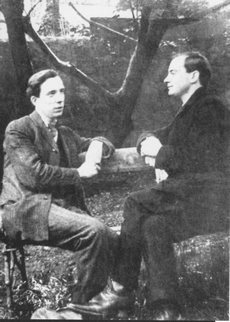 The Pearse brothers: Patrick. right, the chief instigator of the Rising and an author of the Declaration of Independence, and his younger brother Willie, left, his assistant and messenger.
The Pearse brothers: Patrick. right, the chief instigator of the Rising and an author of the Declaration of Independence, and his younger brother Willie, left, his assistant and messenger.
Maundy Thursday April 20th 1916 - the start
The British government was well aware that something was going to be attempted. Not least, they had had intelligence from the American government to that effect though it is uncertain whether the Foreign Office passed it on the administration in Dublin Castle. The key figures in the Rising were well known to the authorities in Dublin Castle and had been watched for months by the “G” division of the Dublin Metropolitan Police.
Good Friday April 21st - Sir Roger Casement captured at Carrahane Strand, County Kerry
This was a major foul up by the Irish Volunteers but had the unintended effect of wrong-footing the British authorities who assumed that his capture would mean that the Rising would not go ahead. (In fact, Casement had become convinced that the Rising would be a disaster and had come to convince the leadership that it should be cancelled). The communication between Germany and the Irish Volunteers was via the United States and Irish sympathisers there. This was slow and uncertain. The Irish leadership changed their mind about when they wanted the arms from the Aud, and also Roger Casement to arrive, but did so too late for the Aud and the U-boat to be notified. So, when Casement came ashore from U-19 there was no-one to meet him. He was arrested by a local RIC police sergeant armed with a rifle for which he had no ammunition, after his abandoned rowing boat had been spotted by a local woman.
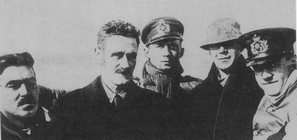
Easter Saturday April 22nd – the Aud is intercepted, and scuttled
The German freighter Aud loaded with arms for the Irish Volunteers was intercepted by the Royal Navy off the West coast of Ireland, aided by the Royal Navy knowing the German naval codes (as the Russians had provided them with captured code books early in the war). The Aud was taken under escort to Cobh harbour near Cork but the crew scuttled her near the harbour. In fact, the Aud had used a circuitous route to avoid detection, going as far north as the Artic circle. She was originally a British freighter that was caught in the Kiel Canal when the war started in 1914, given a German name and then given a Norwegian name for the arms voyage to Ireland. (Photo above right is Roger Casment, 2nd left, on the deck of the U-19 with two German officers. Note that Casement is older and more haggered than the more usual photos of him, which are of him as a young man. Here, he was 51.)
Easter Sunday 23rd April – is the Rising on or off?
- Eoin MacNeill called off the Rising
MacNeill was the head of the Irish Volunteers but, like many of them, was not a soldier. He was a university professor. He believed that the loss of the arms and ammunition aboard the Aud made the Rising impractical. The key method of communicating his decision was an advertisement in a Sunday newspaper.
- A countermanding decision that the Rising should go ahead
On the afternoon of Easter Sunday, the leaders of the Rising met and decided to go ahead with it but on a smaller scale and only in and around Dublin. Such was the chagrin directed at MacNeill in certain quarters that one of Connolly’s associates in the Irish Citizen Army wanted to go round to MacNeill’s house and shoot him!
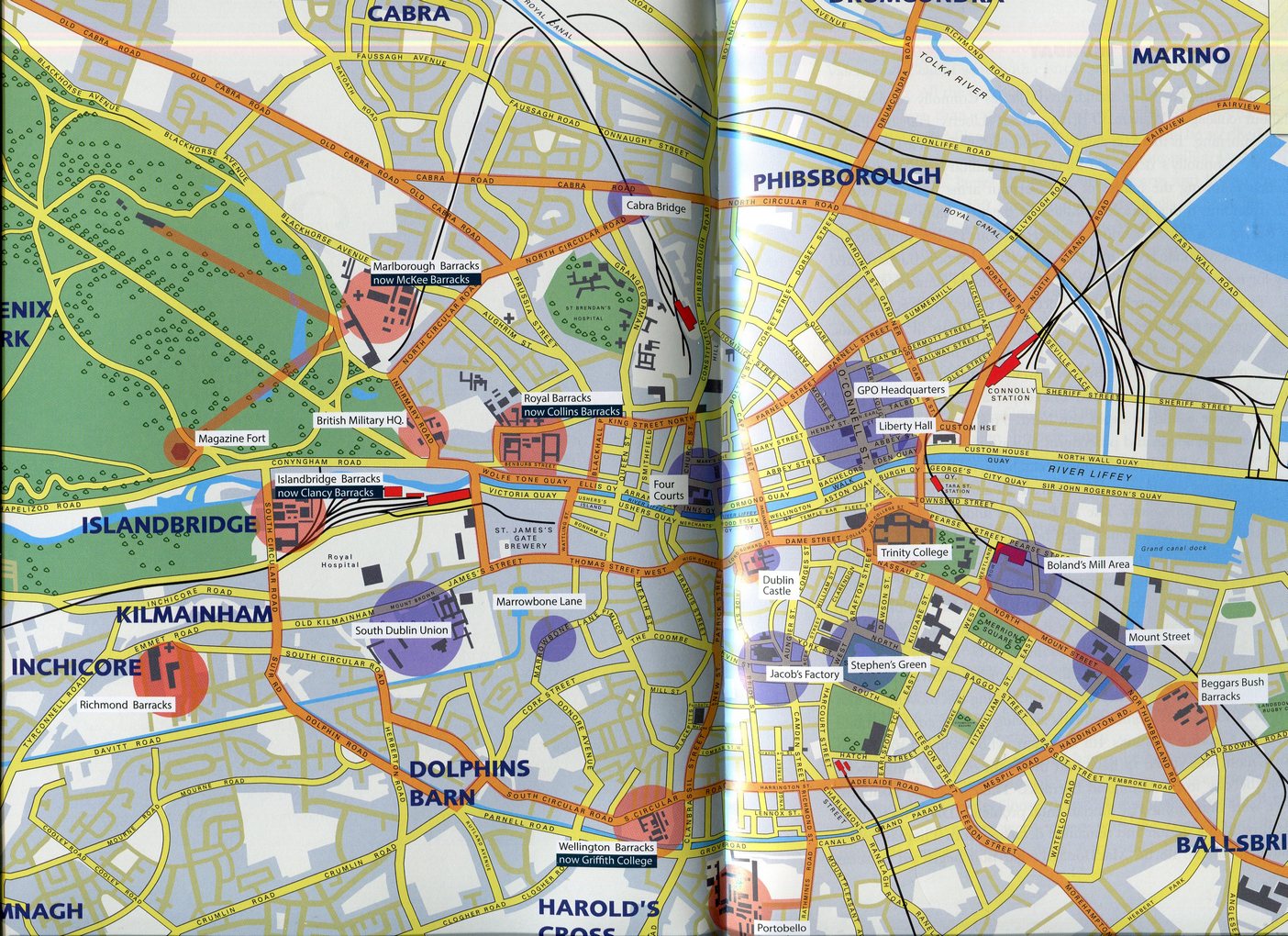
Map of central Dublin showing the rebel positions in purple and the British army positions in orange. From "Proclaiming a Republic" Darragh Gannon
Easter Monday, 24th April 1916 - the Rising actually happens
- Important buildings in central Dublin taken
At midday on Easter Monday the General Post Office (GPO) and other buildings in central Dublin were taken by the rebels. Patrick Pearse read a Declaration of Independence somewhere in the proximity of the GPO. Customers and staff were ushered out of the GPO, and one British officer waiting in a queue was taken prisoner. Other buildings taken by the rebels included Jacob’s biscuit factory, the Mendicity Institute (a mental health hospital), the Four Courts, and Boland’s Bakery. The rebels seized weapons from the magazine fort in Pheonix Park.
- Unarmed DMP constable James O’Brien killed at Dublin Castle
Dublin Castle was the centre of British administration in Ireland and home of the intelligence services. The rebels made a ham-fisted attempt to capture it. The first casualty was an unarmed DMP police officer who manned the gate of the castle and who put out his arm to stop and talk to the group walking through the main gate. In fact, the guard at this nerve centre of the British administration was only 6 soldiers with a potential back-up of 20 soldiers from a nearby barracks. It seems unlikely that there was any live ammunition in the castle for the soldiers’ rifles.
Arthur Norway, the Secretary to the Post Office in Ireland, had been called to a meeting in Dublin Castle with Sir Matthew Nathan, Under Secretary of State for Ireland and the Major Ivor Price of military intelligence. They heard the shot and the general commotion. Norway writes that he said “What was that?” and Nathan responded “That is the revolution”. The major ran down to see what was happening, saw the rebels in the courtyard and opened fire with his revolver. The rebels ran off. It seems that the major’s revolver was the only weapon with live ammunition used by the British in the castle. (Norway’s younger son became a novelist but used his mother’s name and is known as Neville Shute).
- British intelligence was at Fairyhouse races
There had been a general assumption by the intelligence services that the capture of Casement, the Aud and the lack of anything happening as planned on Easter Sunday meant that the Rising had been cancelled. So, they were off en masse at the Irish Grand National horse race at Fairyhouse, outside Dublin (and Regan was of course amongst them).
- German navy shelled Lowestoft
We mentioned above this support from the German navy.
- Soldiers from Irish regiments called out
The troops available were the Irish regiments, first and foremost the Royal Dublin Fusiliers.
- 2nd Lt Neilan, RDF
One of the first casualties was 2nd Lt Gerald Neilan who was killed by a sniper on the Quays in Dublin. The following week his mother received two official letters. One told her of Gerald’s death. The other told her that her son Arthur Neilan had been arrested as one of the rebels and was being sent to England (in fact to Knutsford). He died in 1944 and the brothers are buried in the same grave in Glasnevin cemetery in Dublin.
- British army lancers were ambushed at the Four Courts
There was a cavalry charge by the British army down O’Connell Street (then Sackville Street), which was repulsed. It seems incredible to think of a cavalry charge down the main street of a British city but that is what happened.
- Elderly, unarmed, members of the Veteran Defence Force were ambushed marching along Northumberland Road.
Pearse ordered his men not to fire in future on unarmed persons. It was being somewhat hopeful, given the chaos ensuing and the trigger happy attitude of many on both sides. The defence volunteers wore an arm badge with “GR” on it for Georgius Rex but were known in Dublin as “gorgeous wrecks”.
- Michael Cavanagh was shot dead by the rebels as he tried to retrieve his handcart from a barricade at St Stephen’s Green.
- Neither Birrell nor General Friend returned to Dublin
Neither the Secretary of State for Ireland, Augustine Birrell, nor the GOC for Ireland, General Lovick Friend bothered to return to Dublin at this stage. They clearly underestimated the gravity of the situation, or were not very diligent, or both. Their lackadaisical attitude eventually cost them their jobs.
Easter Tuesday 25th April 1916 - the Rising continues
- The army placed machine-guns in the Shelborne Hotel and forced the rebels from the trenches they had dug in St Stephen’s Green. The rebels fell back to the Royal College of Surgeons.
- Army used 18pdr guns with shrapnel shells
Ireland was part of the UK, so the only artillery available was that used to train troops, as all other artillery was on the front line in the war. So, four worn-out 18-pounder field guns were brought up to Dublin from the training depot in Athlone. As these were for training troops for the Western front, the ammunition available was shrapnel shells which would be used against enemy troops in open country. However, the rebels were in the GPO and other buildings in the middle of Dublin, so the shrapnel shells fired at it had little effect (but the marks of the shrapnel are visible on the GPO today).
- Looting became more widespread, having started on Monday night. The unarmed DMP were not on the streets. The pacifist Francis Sheehy-Skeffington who had with others been trying to stop the looting was arrested by Captain John Bowen-Colthurst who led a group of forty soldiers into downtown Dublin. He shot two men, one of whom was a volunteer trying to stop looting and the other a teenager going home. They arrested two pro-unionist journalists, Thomas Dickson and Patrick McIntyre. Dickson, McIntyre and Sheehy-Skeffington were shot by firing squad on Wednesday morning on Bowen-Colthurst’s orders.
- Fighting inside a hospital – South Dublin Union
Rebels repulsed a British army attack; patients were still present in the hospital.
RDF then suffered 23 casualties when ambushed in Parliament Street
- 12pdr gun shelled Boland’s Bakery
The one artillery gun that did have high explosive shells available, which was the type of ammunition that should be used against buildings, was on the deck of the armed fisheries vessel HMY Helga. So, the Helga was brought up the River Liffey and initially shelled the nearest rebel position, at Bolands Bakery.
- Rebels occupied the Imperial and Metropole Hotels near the GPO, and parts of Henry Street.
- Lord Lt - Lord Wimborne declared martial law
Wimborne was the figurehead of the British regime in Dublin. In the absence of Augustine Birrell, the Secretary of State for Ireland and the senior political figure, Wimborne took it upon himself to declare martial law. He did not consult with the government in London.
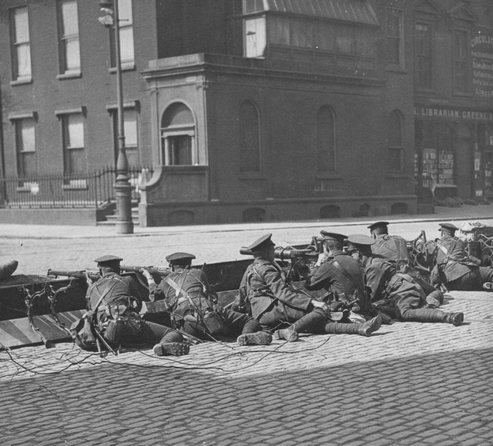 Wednesday 26th April
Wednesday 26th April
- General Maxwell appointed as new GOC Ireland
Sir John Maxwell was appointed largely because he was available in London, having recovered from illness. Don’t forget that this was early 1916 when any talent that there was in the general staff would be likely to be sent to the Western Front. Anybody considered for the Ireland role would be somewhat second class. Asquith had considered appointing Ferguson but thought the fact that he was involved in Gallipoli, where there were considerable Irish losses, might mean he went to Ireland with a cloud over him. In the event, Maxwell is remembered by Irish republicans as a cross between Hitler and Stalin! This is touch unfair, as Maxwell was fixed by Asquith with imposing a military solution on what was a political problem. This was typical of Asquith – indecisive and, frankly, bumbling. By early 1916, the other politicians in his own government were getting tired of his indecisiveness and disorganisation, issues which led to his replacement by David Lloyd-George in December 1916.
The fact that Maxwell knew little of Ireland did not help his efforts which, at best, were ham-fisted and insensitive. However, he was a general of his era, and an era when ordinary soldiers on the Western Front were shot by their own army for minor issues and health problems, including suffering from shell shock. He is said to be the man that lost Ireland for the British, but that is perhaps a harsh judgment. (Photo above right is of British army during Easter week. Note there are no steel helmets available, as this was a British city, not the Western Front.)
- British army in the Gresham Hotel fired on the GPO.
- Civilian rights under s1 DoRA 1915 suspended
The right of civilians to a civilian trial under s1 of DoRA was suspended but there seems to be no power to do so in the Acts. Crucially, this meant that the rebels were tried by military field courts martial, not by a judge and jury.
- 2 bns Sherwood Foresters reached Kilmainham from Dun Laoghaire, unopposed
- 2 bns Sherwood Foresters were stopped by 17 rebels at Mount St bridge
The soldiers were ordered by Brig Gen Lowe to use frontal assault, against the wishes of Col Maconchy and his officers who were on the spot. In fact, it would have been simple to either outflank the defenders by using another of the adjacent canal bridges or ignore the rebels and head for central Dublin via one of the other bridges. This is an example of Western Front tactics of that era of taking anything in front of you by frontal assault. The Sherwoods kept trying to rush the defenders in Clanwilliam House, on the far side of the bridge with little effect and substantial casualties. They were also suffering enfilade fire from two men in one of the houses on Northhumberland Road. A clergyman and doctor and nurses from a nearby hospital braved the shooting to remove the injured and the dead.
The Sherwoods had few grenades and no machine guns. Later in the day, a machine gun and grenades did arrive. The bridge was eventually taken at a cost of 234 army casualties. The rebels had suffered 5 killed and one captured.
- De Valera did not reinforce rebel defenders
Although De Valera had more than 100 men in Bolands Mill nearby, he failed to reinforce the detachment at Mount Street bridge. More generally, had the rebels sought to hold strategic points such as bridges, they would have had more success than by holing up in buildings in central Dublin and waiting for the army to surround them. (Photo below right: De Valera after his surrender).
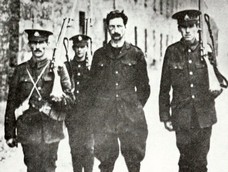
- Fighting around Four Courts and North King St
Dublin Fusiliers captured the Mendicity Institute and laid siege to the Four Courts. The Mendicity Institute garrison under Sean Heuston surrendered just after midday.
Thursday 27th April
- Chief Secretary Birrell belatedly arrived from London
He had totally failed to appreciate the gravity of the situation and to act with any sense of urgency. He was absent in London at Easter even though the British government was aware of some sort of “rebellion” being planned for Easter weekend.
- British army artillery shelled O’Connell St and GPO
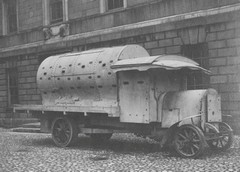
- British army captured Capel Street bridge and attacked the Four Courts and the South Dublin Union
- James Connolly was wounded on Middle Abbey Street and was treated in the GPO by a captured British army doctor. Hoytes Oil works exploded, burning down several buildings. (Photo right: improvised armoured vehicle, using a factory boiler. There were no proper armoured vehicles in Dublin in 1916).
Friday 28th April
- General Sir John Maxwell arrived in Dublin.
- Burnt out vehicles, trams and dead horses and people littered the streets
- There was continuous shelling of central Dublin. The army now had more and better guns, and high explosive shells.
- Ashbourne, County Dublin – the rebels took the RIC police station and 11 police were killed.
- Evening: the GPO was on fire; the rebels evacuated the GPO and Metropole Hotel to Moore Street, behind the GPO, under heavy fire.
- 2nd Lt Crockett, Inniskilling Fusiliers was fatally wounded at night by RDF sentry (and we mention him as he was a relation of Trevor’s wife).
- North King Street: 15 local men killed in buildings by the army, the bodies showing bullet and bayonet wounds: the military inquiry opined that it seemed to have been as a result of ambiguous orders from Gen Lowe not to take any prisoners.
- CQMS Robert Flood RDF whose detachment was guarding the Guinness brewery panicked and had his men executed Lt Lucas and a watchman, Mr Rice, and then also executed two other men who had come looking for the first two, that is Lt Worsley Worswick and another Guinness employee, Mr Dockery. (Photo below right: Winifred Carney, secretary to James Connolly and recorder of events in the GPO in Easter week).
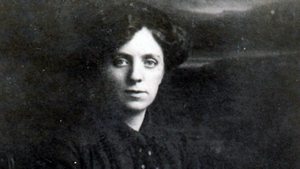
- Saturday 29th April – the initial surrender
- Rebel leaders held a meeting at 16 Moore Street (having evacuated the GPO)
- Nurse O’Farrell walked round to the other rebel positions to tell them of the surrender.
- Connolly surrendered his Irish Citizen Army, even though lying wounded.
- Edward Daly surrendered the rebel contingent at the Four Courts.
Sunday 30th April – the end
- The Rising was over and central Dublin lay in ruins.
- De Valera surrendered at Boland’s Mill, though there was difficulty in finding any British army contingent to surrender to.
- Rebel contingents at St Stephens Green and Jacob’s factory surrendered.
- The contingent at the South Dublin Union surrendered.
- Rebels in Ashbourne, County Dublin surrendered.
- Remaining rebel groups in Dublin surrendered.
- Rebel prisoners needed to be protected by soldiers from crowds of locals
- Rebels were held outside the Rotunda overnight, and their treatment created simmering resentment.
- They were processed by the army and “G” divn DMP on Monday
Sean Harley recounted how he, as a 14 year old, was asked his age by an officer. When he told him, he was told to go home to his mother and tell her what he had done. In fact, all those under the age of 19 are released on the Monday after a “pep talk” about their folly.
- The leaders were held in Kilmainham jail, Dublin
- The ordinary rebels were held in Dublin army barracks.
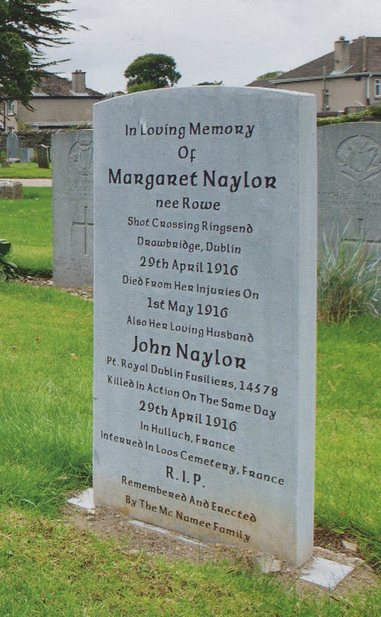 Easter week casualties
Easter week casualties
The bulk of the fatalities were civilians – 318 of them, including 38 children. (Some sources place this higher at 374 civilians). There were 66 rebels killed, 23 police officers (DMP and RIC) and 128 soldiers. 40 of them Irish. The civilians were often poor people in downtown Dublin, typically out looking for food. The figures also reflect poor discipline, and indeed panic, on the part of both the army and rebels who were both inclined to be trigger happy. The case of the Naylor family is particularly poignant, as the wife was fatally shot near Boland’s mill when she was out looking for food for the children, and her husband was killed on the same day at Hulluch on the Western Front (see photo left from Grangegorman military cemetery).
By way of comparison of the Rising with events on the Western Front, the RDF at Hulluch had over 500 fatalities in that week.
Photos of central Dublin in ruins - the Westropp collection of the Royal Irish Academy
These were taken by Thomas Johnson Westropp (1860-1922) who was an archeological photographer who took his wonderful set of photos just days after the end of the Rising. He is believed to have taken at least 44 photos. One set is in the Irish National Library, another in the library of Trinity College Dublin and a third with the Royal Irish Academy. They are part of the Digital Repository of Ireland and all the known photos are on line - Digital repository of Ireland
The devastation of the centre of a British city is quite shocking. Could such destruction have been visited on a city but for WWI?




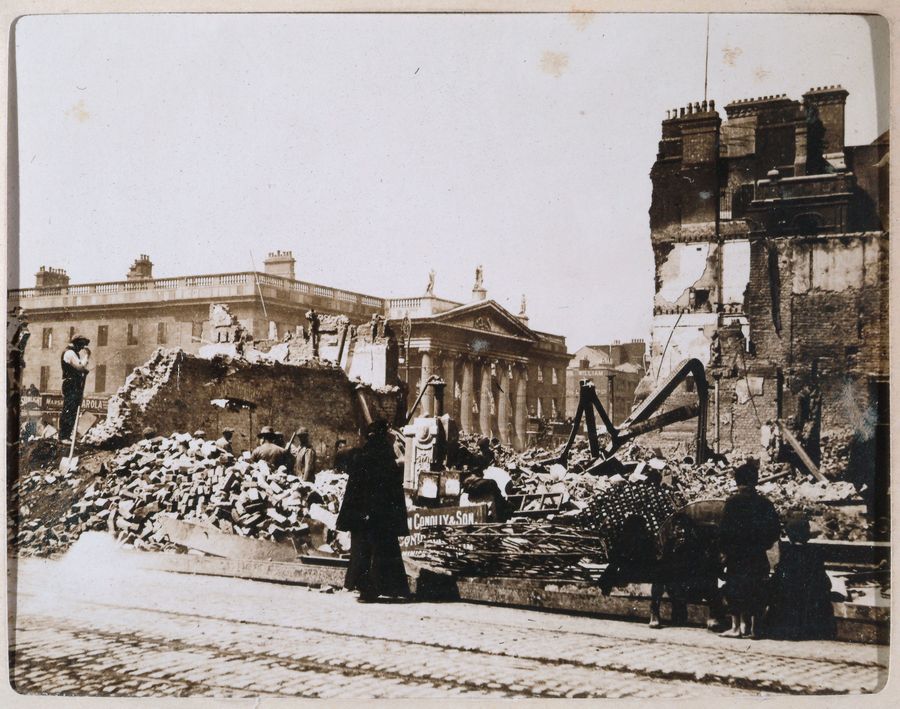
The next section is here